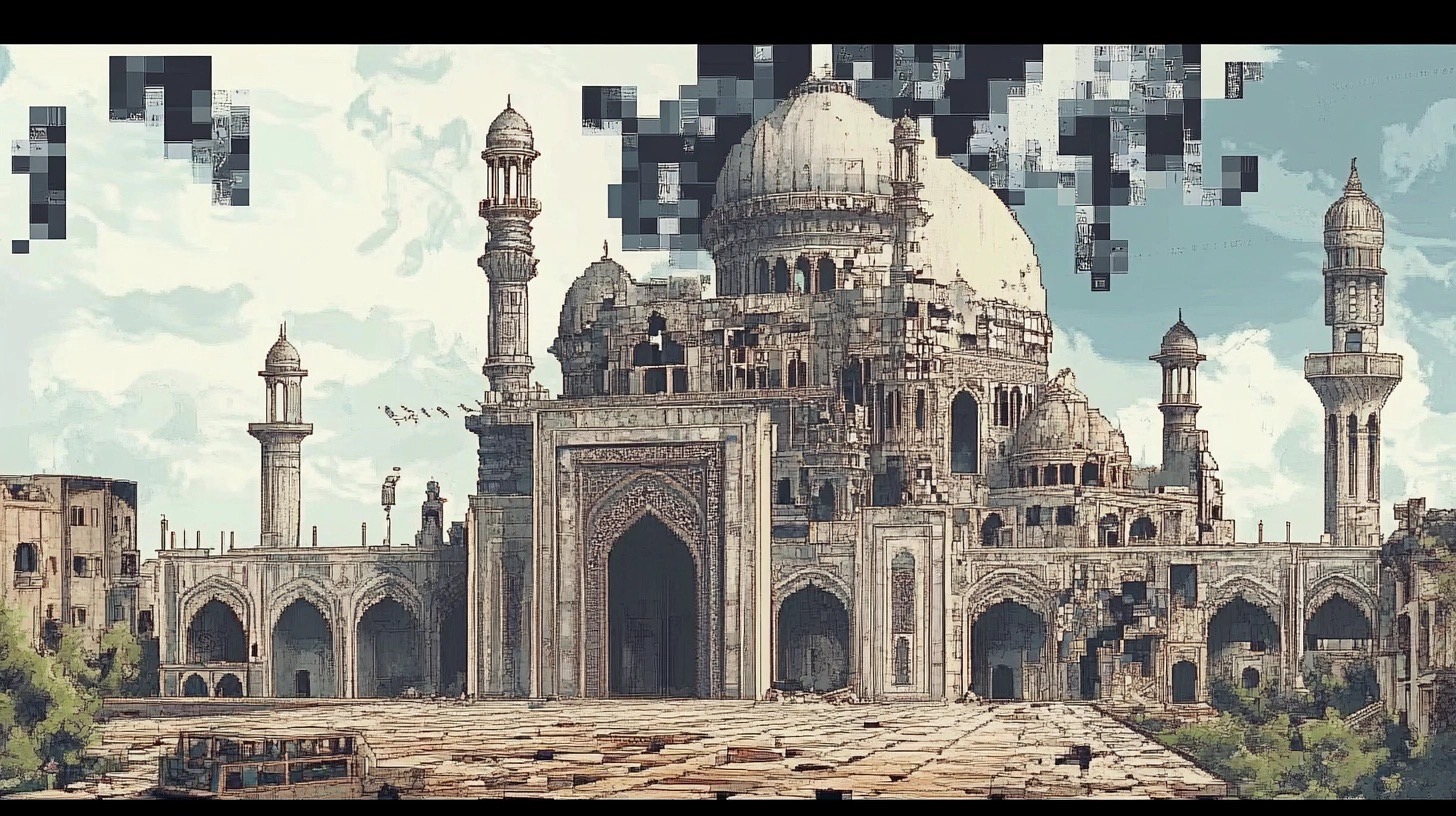
Srinakharinwirot University
I-na Phuyuthanon

Abstract :
Echoes of Patani: AI-Reconstructed Memories is a creative project inspired by the rich history and cultural diversity of Patani, encompassing present-day Pattani, Yala, and Narathiwat in southern Thailand. Drawing on oral histories, visuals, and sounds, the work explores the memories of Patani and how they can be remembered, forgotten, or reshaped over time. By leveraging Artificial Intelligence (AI), this project seeks to simulate and resurrect the echoes of the past, which are slowly fading, offering a fresh perspective on how memory is formed.
Patani, once a thriving center of Malay civilization, had close ties through trade and cultural exchange. However, socio-political shifts and state influence have altered its historical narratives, preserving some aspects while silencing others. In today’s digital age, globalization and media algorithms challenge local memory, often replacing inherited stories with rapid, data-driven imagery.
This project positions AI not merely as a tool but as a narrator, reconstructing lost or hidden memories through generated sound and visuals. It challenges how we define “truth” and “identity” when technology plays a role in shaping the past. Rather than merely archiving history, this work reimagines it, inviting viewers to reflect on what is remembered and what is lost.
Influenced by artists such as Refik Anadol, who transforms data into immersive memoryscapes, and Ian Cheng, whose simulations evolve over time, this project blends artistic expression with cultural inquiry. It brings together art, anthropology, computer science, and social studies to explore the shifting meaning of memory in a digital world.
Ultimately, Echoes of Patani is not solely about retrospection; it is about understanding how identity is perpetually constructed. By employing AI to breathe life into cultural fragments, the work becomes a platform for reflection, questioning, and reimagining the essence of remembrance.
Objectives :
This creative project, grounded in research, aims to explore the convergence of cultural memory, identity, and artificial intelligence through the analysis of contemporary art and critical theory. The study is guided by the following objectives:
- To examine the concept of cultural memory and identity, using Maurice Halbwachs’ Collective Memory (1950) as a theoretical framework. The project seeks to simulate and revive fragmented memories of Patani by employing Artificial Intelligence (AI) as a tool for historical reconstruction. By presenting these cultural memories in innovative narrative forms, the project challenges conventional modes of remembrance and invites new interpretations of the past.
- To experiment with Generative AI and Machine Learning in the artistic creation process, aligning with Rosi Braidotti’s (2013) concept of Posthuman Aesthetics. This framework challenges the anthropocentric approach to authorship and storytelling, proposing that algorithms and other non-human agents can co-create and mediate cultural narratives. The project critically examines how these technologies shape and influence identity formation in the digital age, expanding the boundaries of traditional authorship.
- To engage with Jean Baudrillard’s (1981) theories of Simulation and Hyperreality, by generating synthetic representations—both visual and auditory—of Patani that do not align with historically documented events or spaces. These AI-generated simulations serve as speculative narratives, prompting reflection on the blurred lines between reality and artificiality in an era dominated by digital media and algorithmic culture.
Conceptual Framework :
This project draws on both theoretical and technical frameworks to explore how Artificial Intelligence (AI) can imitate, recreate, and challenge cultural memory and identity within Patani. The project is grounded in three primary theoretical tenets: Maurice Halbwachs’ Collective Memory (1950), Rosi Braidotti’s Posthuman Aesthetics (2013), and Jean Baudrillard’s concepts of Simulation and Hyperreality (1981).
Halbwachs’ theory provides the foundation for understanding how collective memory is reconstructed through AI. The project utilizes historical documents, archival photographs, oral narratives, and audio recordings related to Patani, alongside academic research on ethnic identity, culture, and memory. These materials serve as the basis for AI-generated content, facilitating the recreation of cultural memory.
Baudrillard’s theory informs the critique of AI-generated visuals and sounds that simulate a version of Patani detached from tangible history. These reconstructions question the boundaries between reality and digital fabrication, prompting audiences to reflect on how media and algorithms influence perceptions of truth and reality.
On the technical side, the project employs Generative AI and Machine Learning tools—such as Stable Diffusion, Runway ML, Pika Labs, and ElevenLabs—to simulate visual, sonic, and motion-based elements. AI Style Transfer and Neural Networks are also used to evoke the aesthetic of memory and historical documentation.
Thematically, the project focuses on the 18th to 20th centuries, highlighting periods of socio-cultural transition in Patani. Geographically, it centers on the provinces of Pattani, Yala, and Narathiwat, examining their cultural and historical contexts.
The ultimate outcome is a video art installation that encourages interpretation over definitive conclusions. Guided by Braidotti’s Posthuman Aesthetics, the work repositions AI as a co-creator in the memory-making process and challenges anthropocentric narratives. The audience is invited to critically engage with questions of truth, authenticity, and memory construction in the digital age.
Through this interdisciplinary framework, the project positions AI not only as a creative medium but also as a philosophical tool for reimagining forgotten histories.
Process / Methodology :
This project employs a practice-based methodology that integrates theoretical frameworks with generative AI technologies to reconstruct and reimagine cultural memory. The creative process unfolds in four main phases:
- Data Collection & Research
Primary sources include historical documents, old photographs, oral histories, and field recordings from Patani. These materials are complemented by academic research on identity, culture, and memory. Theoretical frameworks such as Maurice Halbwachs’ Collective Memory (1950), Rosi Braidotti’s Posthuman Aesthetics (2013), and Jean Baudrillard’s Simulation and Hyperreality (1981) inform the analysis of cultural memory and identity. - Material Selection & AI Integration
Using tools like Stable Diffusion and Runway ML, visual simulations of historical Patani are generated from archival references. ElevenLabs is used to synthesize AI-generated voices based on interview data, while AI Style Transfer and Neural Networks recreate the aesthetic of memory and vintage photography. Adobe Premiere Pro and After Effects are then employed to combine these elements with atmospheric effects, such as mist and lighting, to enhance the sense of fragmented remembrance. - Creative Design Process
The narrative is structured around a fragmented, non-linear format. A storyboard and mood board guide the visual composition, while audio layers simulate ambient memory. Glitches, distortions, and missing visual elements are intentionally introduced to reflect the incomplete and mediated nature of AI-generated memory. - Refinement & Exhibition
Early versions of the video installation are reviewed by scholars and community members. Their feedback is used to refine cultural authenticity, narrative clarity, and emotional tone. The final video art is presented as an immersive installation, inviting viewers to critically reflect on issues of truth, memory, and simulation in the digital age.
Through this process, the project positions AI not merely as a technical tool but as a speculative agent for negotiating the blurred boundaries between history, identity, and invention.
Techniques and Materials :
This project combines generative technologies, archival aesthetics, and video art techniques to simulate and reimagine cultural memory. Central to the creative approach is the integration of Artificial Intelligence (AI) as both a technical tool and a conceptual collaborator in the process of memory reconstruction.
Generative AI Tools
Visual materials are created using Stable Diffusion and Runway ML, which enable the generation and manipulation of imagery based on textual and visual prompts sourced from historical references. These tools simulate environments such as old Patani towns, markets, and mosques. Pika Labs supports motion synthesis and scene animation, while ElevenLabs AI Voice Synthesis is used to produce lifelike voices based on recorded local dialects and oral interviews.
Style Transformation
To reinforce the sense of historical distance and subjective memory, AI Style Transfer and Neural Networks are employed to convert images into formats that resemble vintage photography, paintings, or dream-like memory states. This technique emphasizes the artificial and interpretative nature of reconstructed memories, reflecting the nuances of human recollection.
Post-production & Composition
The final artwork is assembled using Adobe Premiere Pro and After Effects. These platforms allow for the layering of AI-generated visuals, synthesized voices, ambient sounds, and digital effects. Elements such as fog, light flares, glitches, and distortions are deliberately incorporated to create a fragmented, immersive atmosphere that evokes the ephemeral quality of memory.
Visual Aesthetics
The visual tone leans toward sepia, monochrome, and warm hues to evoke a nostalgic ambiance. Architectural structures are intentionally depicted as incomplete or glitch-affected, aligning with the conceptual focus on the incompleteness of memory. The scenes are designed with documentary-like perspectives, enhancing the “simulated archive” aesthetic.
Together, these techniques and materials construct a speculative visual narrative that encourages critical reflection on identity, history, and the limitations of technological memory-making.
Result / Conclusion :
“Echoes of Patani A.I.” presents a speculative and experimental approach to reconstructing cultural memory through artificial intelligence. The project yields a range of conceptual, artistic, and socio-cultural outcomes:
- Artistic Outcomes
The final product is a video art installation that simulates fragmented memories of Patani’s historical landscapes. By using generative AI tools, the work visually and sonically reconstructs scenes from the past—markets, mosques, traditional architecture—filtered through aesthetic choices such as glitch effects, sepia tones, and surreal atmospheres. These elements convey the notion that memory is never fully complete but rather subject to distortion, loss, and reinterpretation. - Conceptual Contribution
The project critically engages with three major theoretical frameworks: Maurice Halbwachs’ Collective Memory, Rosi Braidotti’s Posthuman Aesthetics, and Jean Baudrillard’s Simulation and Hyperreality. AI functions not only as a tool but as a narrative agent, questioning the boundaries between historical truth and technological fabrication. It reveals how collective identity can be reconstructed—and potentially reshaped—by non-human intelligence. - Socio-cultural Reflection
By focusing on Patani, a region often marginalized in dominant national narratives, the project re-centers silenced voices and invites broader public engagement with cultural memory. It positions AI as a medium for both preservation and critique, capable of amplifying forgotten histories while highlighting the ethical complexities involved in doing so. - Future Directions
This project opens possibilities for further interdisciplinary exploration between art, AI, and cultural studies. Future developments may include:
- Interactive installations allowing users to navigate reconstructed memory spaces.
- Collaborative projects with local communities to co-create AI-generated memory archives.
- Integration of real-time data and responsive AI to dynamically evolve the artwork.
In conclusion, “Echoes of Patani A.I.” demonstrates how AI-generated art can serve as a powerful tool for speculative storytelling and cultural reflection. It challenges viewers to reconsider what is remembered, how it is remembered, and who gets to remember—offering not closure, but a space of ongoing questioning and imagination.
References :
Barrett, T. (2003). Interpreting art: Reflecting, wondering, and responding. McGraw-Hill.
Benjamin, W. (1969). The work of art in the age of mechanical reproduction (H. Zohn, Trans.). In Illuminations (pp. 217–252). Schocken Books. (Original work published 1935)
Derrida, J. (1978). Writing and difference (A. Bass, Trans.). University of Chicago Press.
Feldman, E. B. (1994). Varieties of visual experience. Prentice Hall.
Manovich, L. (2001). The language of new media. MIT Press.
Paglen, T. (2016). Invisible images (Your pictures are looking at you). The New Inquiry. Retrieved from https://thenewinquiry.com/invisible-images-your-pictures-are-looking-at-you/
Rancière, J. (2009). The emancipated spectator (G. Elliott, Trans.). Verso.
Sterling, B. (2005). Shaping things. MIT Press.
Turkle, S. (2011). Alone together: Why we expect more from technology and less from each other. Basic Books.